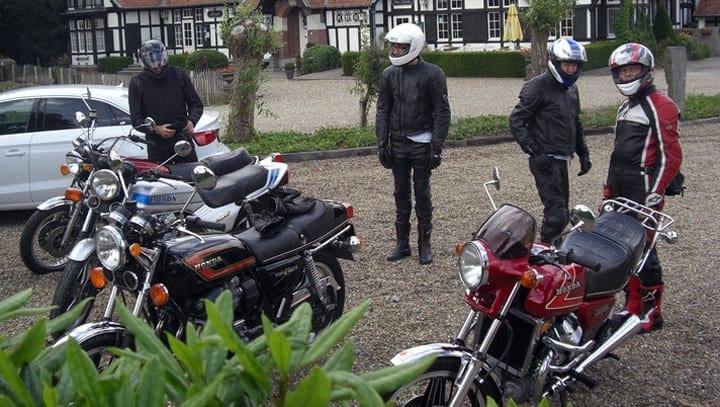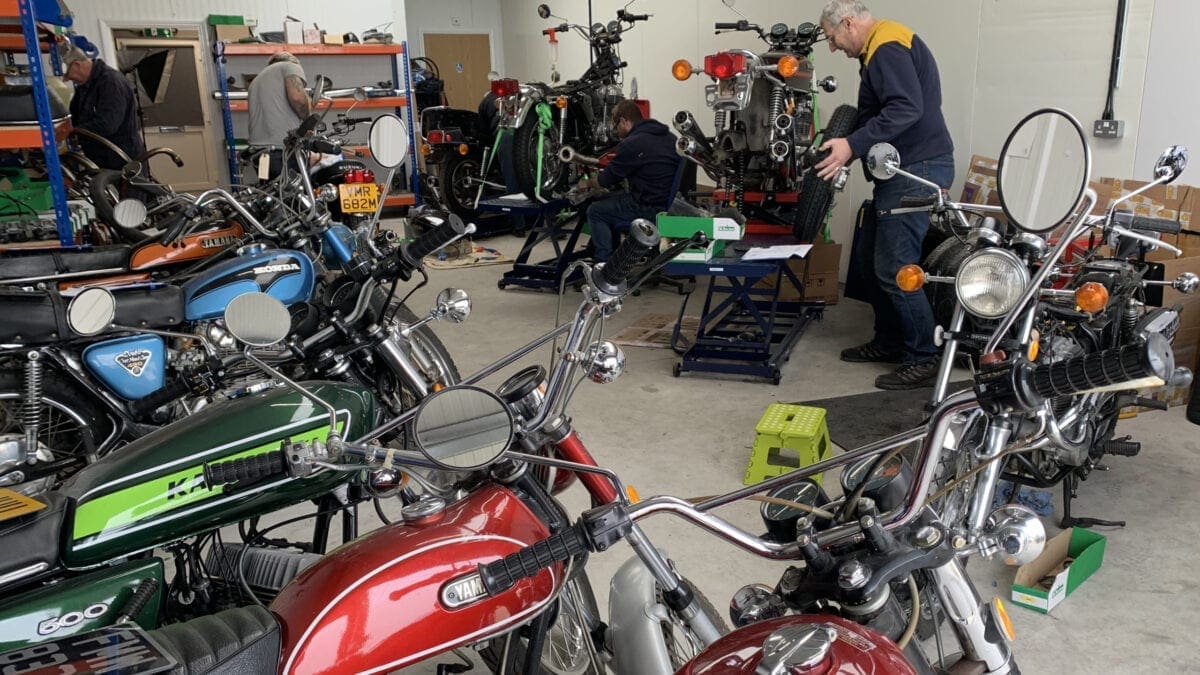Do you need a modern motorcycle to go touring? Hardly. Mark Redfern and his pals from the Vintage Japanese Motorcycle Club take a selection of classic Hondas on a whistlestop tour to the Continent…

One winter, the riders of the Taunton and Bridgwater section of the VJMC concocted a plan to visit the Menin Gate Memorial to the Missing in Ypres, Belgium. The memorial is dedicated to the British and Commonwealth soldiers who were killed in the Ypres Salient of WW1 and whose graves are unknown. It contains the names of 54,896 Commonwealth soldiers who died in the Salient but whose bodies have never been identified or found.
Since its opening in 1927, the citizens of Ypres have expressed their gratitude every evening towards those who gave their lives for Belgium’s freedom. At 8pm, buglers sound the Last Post. Apart from the years of WW2, this ceremony has been carried on uninterrupted since 2 July 1928.
Six of us, including my 16 year old son who would be pillion on my bike, panned to make the trip. We ended up with a 1975 Honda CX500, a 1978 Honda CB750F2, a 1981 Honda CB900F, a 1975 Honda GL1000 Gold Wing and a modern thing. The modern thing was a newish Yamaha Super Ténéré adventure bike which was mocked right up to the point where its sat nav became useful, when we all agreed it wasn’t so bad after all.
The trip wasn’t the exclusive preserve of Hondas, it just worked out that way. That said, they do have a habit of keeping going and lasting well when looked after. They can be a bit of a Marmite bike in that some devotees of, say, Yamaha or Kawasaki won’t touch them. Personally, if it gets me there (and back) and lets me have fun on the way then I don’t care what the badge says.
My personal bike at the time was a silver Honda CB900F. It was just another partially restored Japanese classic, still doing its thing. The most unusual feature was a series of small dents in the top of the silencers. They looked like (and probably were) stiletto heel marks which points to a more glamourous history then the present days of a bunch of middle-aged blokes off on a trip.
The Honda CB900 always lived in the shadow of its larger more illustrious brother, the 1000cc six-cylinder Honda CBX. It never had the glamour of the larger bike but was in many ways nicer to ride and, with 95 horsepower on tap, it could keep up with most bikes back in its day.
We arranged to travel early(ish) on a Saturday in June and arrive back late(ish) on the Monday. After a fry-up breakfast, we set off with a day’s ride ahead of us but nothing too strenuous. When you’re dealing with things which are a bit old and worn out you need to stop regularly to check on everything. We also checked the bikes too…
The day passed with several stops for fuel and even more stops to feed my lad on the back whose stomach is more or less bottomless and able to absorb huge amounts of food without adding an extra inch. The rain stalked us all along the south coast on our way to Kent but we managed to avoid it by moving on just as it caught us up. Little did we know it was planning to ambush us on the way home so we carried on congratulating ourselves on outsmarting it.
The bikes were faultless. No problems were encountered and the limiting factor was us riders. Being four-strokes, the bikes weren’t too thirsty and everyone could easily manage at least 100 miles between fuelling, which meant that coffee stops were the main reason for pulling over. We’d chosen the road nearest the south coast on the basis the scenery might be more interesting.

Early Saturday evening, we rolled into Hythe on the Kent coast just as the rain once again caught us. Normally I just ask for the worst room in the hotel because it saves time but on this occasion I thought I’d take a chance. I was then shown to a perfectly acceptable room (my lad chose the bed nearest the TV, naturally). Unfortunately, one of the beds hadn’t been made from the last guest and there was a used coffee cup on a table.
Having said I simply needed the sheets changing on one bed and some new cups, the kindly lady hotel manager insisted on moving us to the ‘garden room’. Wow, I thought, an upgrade! Er no, it was a prefab annexe in the garden. To be fair, most of the light bulbs worked but it looked like it was furnished when Queen Victoria was still at school. The shower was in the lobby to the annexe with a plain glass door so no modesty required. The hot tap in the bathroom was so keen to please it refused to turn off again, even with the efforts of the same kindly manager. It provided a nice running water feature for the rest of the stay. To keep my lad happy I gave him the bed nearest the bracket on the wall where the TV should have been.
Dinner came late that night courtesy of a local pub. It wasn’t much to look at so expectations were low. We were wrong: it provided Theakston’s ale on tap and an excellent steak for a reasonable price.
Next morning a good breakfast was followed by a short ride to the tunnel followed by a complete farce. Three of the bikes ended up on the train we originally booked and the other two bikes were allocated to two different trains. Fortunately a helpful person from Eurotunnel sorted it out and we ended up on the same train instead of three different ones.
Once on the other side it was a short easy ride of about 65 miles to Ypres with just one stop for fuel and a sandwich (apart from my lad who had a pizza, obviously). Reaching Ypres in the early afternoon we were able to check into the very nice hotel (where everything worked and jokes about Red Cross parcels and escape committees weren’t needed). As always on my many visits to Belgium, the people were friendly and helpful.
A check on the bikes showed all were still fine and none was showing any worrying signs. To be honest, you wouldn’t have done any better with modern bikes. In fact the member of our party who had elected to bring a modern bike didn’t do any better. We were sure it had been a mistake on his part to bring something modern and miss out of the classic fun. Sadly, later events were to prove him right in terms of using a modern adventure bike…
We set off to the Tyne Cot Cemetery. Close to Passchendaele and not far from Ypres, it was the site of some major battles and is now the world’s largest Allied cemetery and the final resting place for nearly 12,000 Commonwealth soldiers. Walking up to the visitor centre you become aware of a female voice from discreetly placed speakers. Every five seconds or so she reads out a name and an age.
In the visitor centre there are numerous exhibits of personal items such as letters showing a little of what was going on at the time. The female voice is louder now and on one wall is a large screen. Each time she reads out a name the image of that person appears on the screen. A simple but very effective way of bringing to life the fact that each of those neat gravestones represents a real life, the person on the screen, smiling when times were happier.
That evening we took a taxi into Ypres for dinner and a beer before we made our way to the Menin Gate itself. We were at the memorial half an hour before the ceremony but, this being a warm summer’s evening, it was already crowded with people of all ages including groups of British schoolchildren.

The ceremony is very simple and that’s how it should be. Standing under the great arch of the monument itself, little is needed to add to the silent witness of the place and the reminder of what took place here. Looking up reveals column after column of lives lost with a wide variety of regiments and ranks included. Colonels were commemorated here alongside privates.
The man leading the simple act of remembrance described the story of just one soldier as a representative of the sacrifice all. He spoke of a Cambridge-educated padre who died trying to warn the men of an incoming artillery barrage.
The last post was played by four men of the local fire brigade during complete silence among the large crowd. Some wreaths were laid by British schoolchildren and others and, this being a larger service than usual, a hymn from a Welsh male voice choir was sung. The respect and gratitude of the Belgians shown at the time the memorial was built is clearly still there and appreciated by the British who come to visit the town.
The town itself was rebuilt stone by stone after the war and looks magnificent, well worth seeing. A town as handsome as this would be a tourist attraction in its own right in the UK. Being the tourist season, the effect was slightly marred by the temporary stalls selling cheap tat to the visitors but don’t let that put you off.
Belgian beer isn’t admired round the world for nothing and several of the local brews were sampled that evening. We inevitably met some other Brits who’d owned some of the bikes we were riding. They spoke the universal language of ‘I used to have one of those’.
The next morning we were genuinely sorry to be leaving so soon. The hotel put on an early breakfast for us but this was the day the rain got its revenge. We had no choice but to brave it and face a slog of wet roads and poor conditions. The combination of heavy rain, wind, acres of standing water on the French motorways with a few HGVs thrown in wasn’t the best but you take the rough with the smooth.
Yet again all the bikes performed faultlessly. A modern bike might have felt more planted on the road and more stable when facing the bow-wave of an articulated lorry thundering alongside. Relying on 1970s brake technology wasn’t exactly ideal, either; our bikes were from the days when discs streamed with water when it rained, and boy did it rain!

At the UK border control I was stopped, still sat on the bike, for quite a while by a police officer with a seemingly endless string of questions. Where have you all been? Is it just Hondas or any classic bikes? This was followed by ‘I remember those CX 500s…’ Just a routine chat, then. He had plenty of time on his hands as my somewhat damp passport wouldn’t scan for his UK Border Force colleague.
We’d moved our booking on to an earlier train at the tunnel – but only the booking, that was as far as it went. There was a train broken down in the tunnel so nothing was moving. There we were with all the other bikers, standing in the rain, chatting together as bikers do. And then, bless ’em, the French took pity on us and opened one of the trains just so we could all get in the dry and warm(er). We were also the first train to move about an hour later.
Back to Blighty and a bit more rain but nothing as bad as we’d already encountered. By the time we reached Fleet Services the sun had come out and we were able to stop and gently steam ourselves dry in the welcome warmth. Then followed an enjoyable ride down the A303, stopping only to fuel the bikes (and my 16 year old) one last time. After getting back to my place, the two of us remarked about how, despite the weather in France, we’d all got back in one piece.
Bizarrely, it must have been almost at that precise moment a few miles away that one of our number, Andy came a cropper. He was filtering past a queue of cars on his Honda CB750 when some numpty opened the door of his stopped car, and knocked Andy off – just 50 yards from his home! The result was a damaged bike and a damaged Andy with five hours in A&E.
Apart from that damage, none of the bikes came back any the worse for wear. Yes, a modern bike would have eaten up the miles more easily and probably provided some hard luggage to keep everything dry too. But it was worth slightly slower pace and more frequent fuel stops just to experience classic biking abroad.
Eurotunnel emailed apologies for the delays and refunded our train fares for both the outward and return journeys. Yes, we had problems both ways but we also had some staff who did their best for us.

Was it a good trip? Definitely. The only thing we’d have done differently is to add an extra day and stay longer. The contrast of good times and laughs with good mates contrasted with the deeper meaning of what we saw when we were there. And it wasn’t lost on us that we could enjoy that freedom because of the sacrifices made by others.
——–
Words and photos by Mark Redfern
Somerset Classic Motorcycles is run by Andy Taylor and Mark Redfern and focuses on Japanese classics from the 1970s. With a team of experienced engineers they offer everything from newly found survivors, just waiting for a new owner to get them back on the road, right up to fully finished bikes which are as good or better than they were when new.

Mark and Andy will give an honest view of the condition of bikes and the availability of spares and replacement parts. For people looking for a lighter bike with an electric start, or maybe just something to add to the collection, they can usually find something which fits the bill among their stock of 1970’s Japanese machines. They deliver across the UK. See somersetclassicmotorcycles.co.uk




